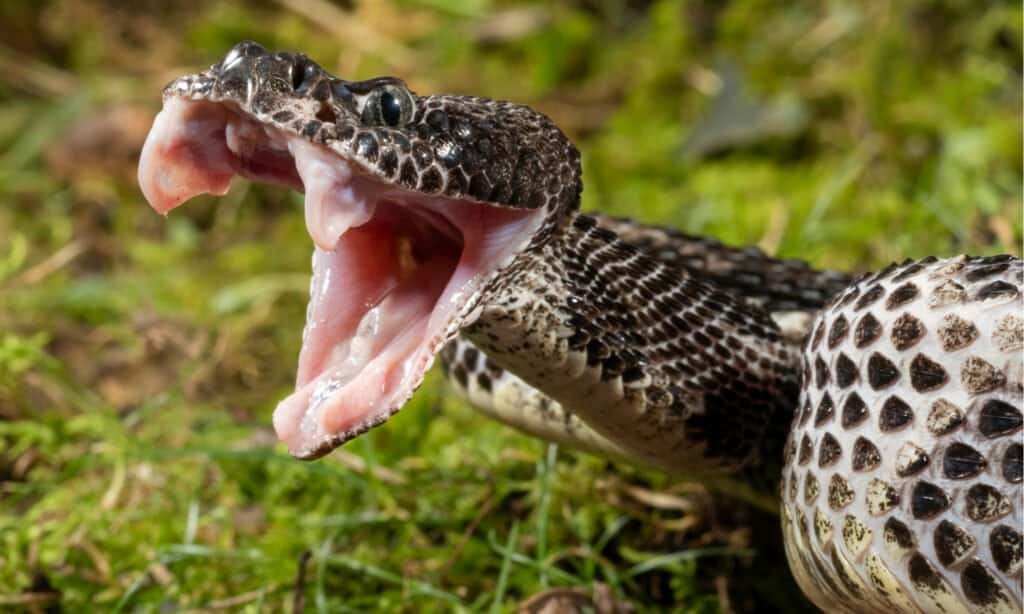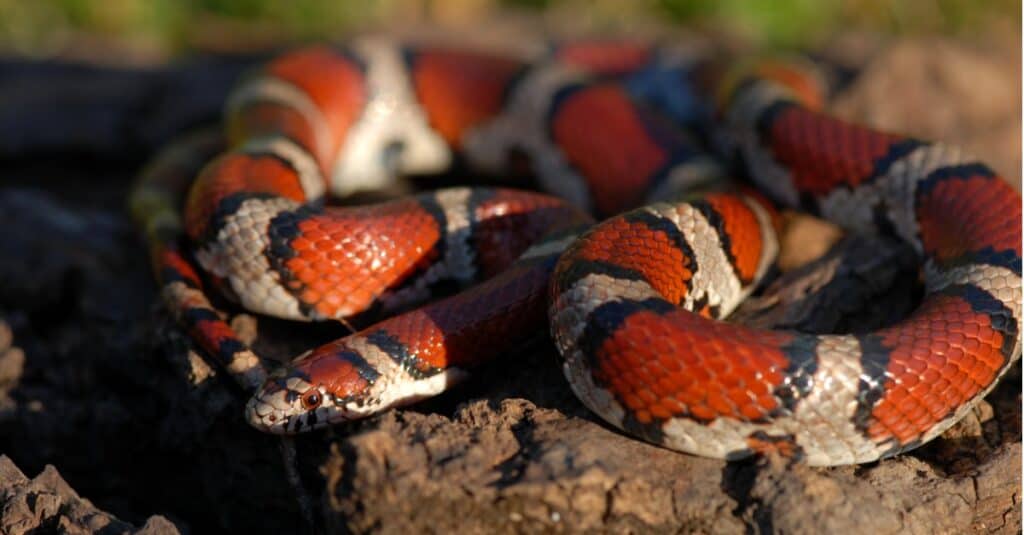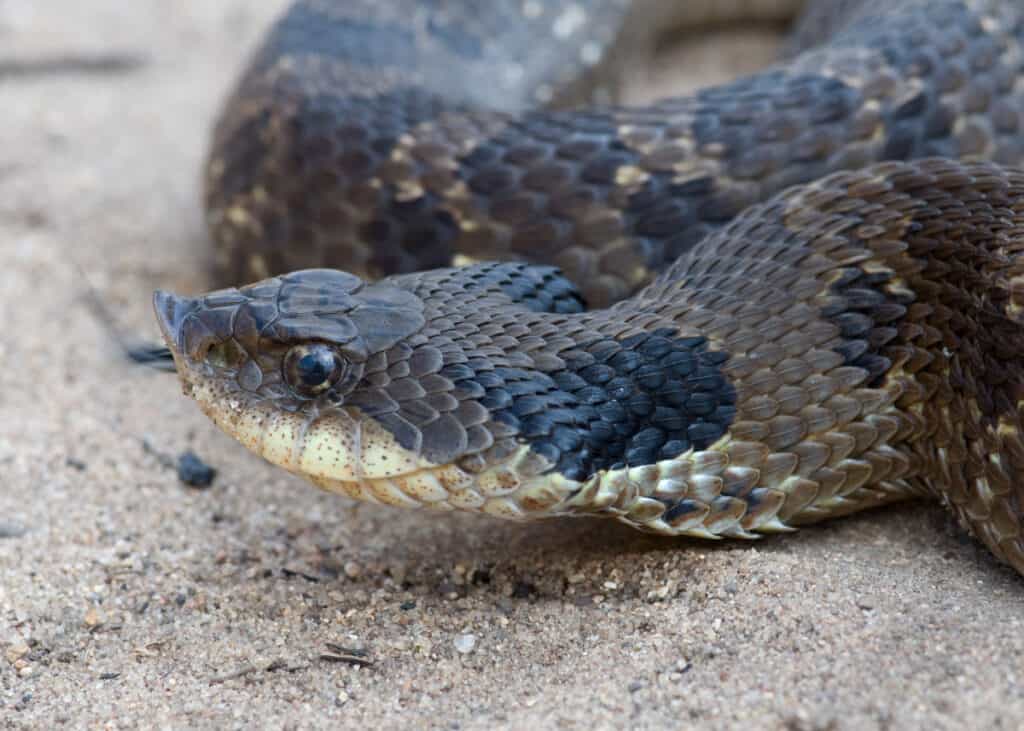Snakes play a vital role in the ecosystems of Indiana as both predators and prey. They are an important source of food for many predators like weasels, birds of prey, and coyotes. They also eat many pests like rodents and bugs. Snakes help to keep populations of these smaller animals in check. Unfortunately, snakes in Indiana are commonly misunderstood and killed out of fear.
There are more than 30 different species of snake native to the state, but only four are venomous. Indiana’s venomous snakes include copperhead and cottonmouth snakes, as well as timber and eastern massasauga rattlesnakes. Let’s take a closer look at the two types of rattlesnakes in Indiana.
1. Eastern Massasauga

The eastern massasauga’s greatest weapon is its “cryptic” camouflage that allows it to hide in plain sight.
©Ryan M. Bolton/Shutterstock.com
| Eastern Massasauga | |
|---|---|
| Range | Northern 1/3 of Indiana |
| Length | 18-30 inches |
The eastern massasauga rattlesnake is rare in Indiana and only lives in small populations in the northern third of the state. This snake is a federally threatened species and an endangered species in Indiana. Eastern massasaugas prefer wetter habitats like edges of lakes, marshy grasslands, and forested swamplands. In fact, the Chippewa word “massasauga” means “great river mouth,” like the massasauga’s preferred habitat.
Massasaugas occasionally live in woodlands and dry prairies as well. Eastern massasauga rattlesnakes are most common from April through November. In the spring and fall, they often bask in the sun to warm their cold-blooded bodies. During the winter months, they hibernate or brumate in crayfish burrows, rock crevices, and old stumps to stay warm.
Eastern massasauga rattlesnakes are 18-30 inches long. These snakes are often gray with dark brown or black blotches along their backs and sides. This cryptic coloration helps massasaugas to blend in as they hide amid shadows and natural debris. An eastern massasauga rattlesnake is typically easy to identify by looking for its iconic rattle, which is formed by keratin rings at the end of its tail. However, young rattlesnakes may only have one button or just a few small rings, and the rattles of older snakes can break off occasionally.
Eastern massasauga rattlesnakes are not known to be especially aggressive. In fact, most massasaugas are shy and prefer to hide by blending into their surroundings. However, these snakes have very toxic venom, so it is best to give them a wide berth. Eastern massasauga rattlesnakes eat a variety of different animals, like mice, voles, shrews, birds, insects, lizards, amphibians, and crayfish.
2. Timber Rattlesnake

Pay close attention while in timber rattlesnake territory, as they have excellent camouflage.
©Joe McDonald/Shutterstock.com
| Timber Rattlesnake | |
|---|---|
| Range | South-Central Indiana & Brown County State Park |
| Length | 24-48 |
Timber rattlesnakes only live in south-central regions of Indiana. They are extremely rare to see and are considered an endangered species in Indiana. In fact, one of the few places where timber rattlesnakes are occasionally observed is in Indiana’s Brown County State Park. Indiana’s Department of Wildlife Resources has been tracking the populations here and has reported at least 10 or so timber rattlesnake dens in the park. However, these are far away from populated visiting areas, and there has not been a single rattlesnake bite in the park for at least 30 years.
You are most likely to see a timber rattlesnake in Indiana during their breeding season in July and August when male snakes are out searching for mates. The venom of a timber rattlesnake is toxic and deadly, but these snakes are not quick to attack or bite. In general, timber rattlesnakes are calm, docile, and do their best to avoid humans. They primarily eat gray squirrels, eastern chipmunks, and birds in Indiana.
Timber rattlesnakes have large, bulky bodies that are 24-48 inches long on average, although many have been known to grow even larger. These snakes have strongly keeled or ridged scales that give their bodies a rough texture. Timber rattlesnakes in Indiana are mainly yellow, with dark chevron crossbands spaced out along the length of their bodies. Their tails are black just before the rattle. However, since baby rattlesnakes do not have full rattles yet, and older rattlesnakes may lose their rattles, this is not always a surefire way to identify a rattlesnake.
What To Do If You Encounter a Rattlesnake

If you see a rattlesnake, do not panic.
©Joe McDonald/Shutterstock.com
It is highly unlikely that you will ever encounter a rattlesnake in Indiana. However, it does happen on occasion, so it is important to know what to do. Whenever you are in an area where rattlesnakes may live, wear taller boots and long pants to protect your legs and ankles. Many rattlesnake bites occur because the snake is accidentally stepped on, so be sure to pay careful attention to where you are walking or hiking. If you have a pet with you, keep it secured with a leash. Do not let your dog sniff in piles of leaves or forest debris where rattlesnakes may be hiding.
Rattlesnakes often curl up while they are waiting to ambush prey or basking quietly in the sun, and they do not have any desire to attack or fight. So, if you see a rattlesnake, do not panic! Give the snake a wide berth of at least 6 feet or more and leave it alone. If you are bitten by a rattlesnake, it is important to stay calm and get medical attention as soon as possible.
Other Snakes in Indiana
In addition to Indiana’s four venomous snakes, there are also over 30 species of harmless snakes living in the state. Let’s take a look at a few of these other snakes that call Indiana home.
Milk Snake

The common name “milk snake” originated from the false belief that these snakes milked cows.
©iStock.com/Shoemcfly
| Milk Snake | |
|---|---|
| Range | All of Indiana |
| Length | 24-48 |
There are two subspecies of milk snakes in Indiana: the eastern milk snake and the red milk snake. Milk snakes grow between 24-48 inches in length and have smooth, somewhat glossy scales. Their bodies are cream, gray, or tan, with red or reddish-brown blotches or crossbands. These red markings are outlined with black, separating them from the lighter base coloring of their bodies. The colors and patterns of milk snakes act as a defense by mimicking venomous coral snakes. However, milk snakes are nonvenomous and completely harmless. In addition, there are no coral snakes living in Indiana.
Eastern Hognose Snake

The eastern hognose’s sable morph is extra dark but with translucent scales around the chin and belly.
©Gerald A. DeBoer/Shutterstock.com
| Eastern Hognose Snake | |
|---|---|
| Range | All of Indiana Except for East-Central Regions |
| Length | 24-48 inches |
The eastern hognose snake is commonly mistaken for a rattlesnake, although it is harmless to humans. There are a few unique characteristics to look for to identify an eastern hognose snake properly. For example, this snake has a slightly upturned snout that looks like a hog’s nose. In addition, there is not a rattle at the end of the snake’s tail.
Eastern hognose snakes live throughout Indiana except for the east-central regions of the state. These snakes come in many different colors and patterns. In Indiana, however, eastern hognose snakes are often grey, brown, or yellow and have dark irregular blotches along their backs.
Bullsnake

When threatened, the bullsnake rears up in an S-shape, hisses, and vibrates to mimic the rattlesnake.
©Markparker1983/Shutterstock.com
| Bullsnake | |
|---|---|
| Range | Southwest & Northwest Corners of Indiana |
| Length | 48-96 inches |
Bullsnakes live in the prairie habitats of the southwest and northwest corners of Indiana. These snakes are often mistaken for rattlesnakes. However, bullsnakes are nonvenomous and harmless to humans. They have tan or yellow bodies with brown, black, and reddish-brown blotches along their backs. These markings are typically darker near the head and tail of the snake.
When it feels threatened, the bullsnake will hiss loudly. The bullsnake and the eastern hognose snake are actually the only snakes in Indiana that use this defense when they feel threatened.
Common Water Snake

Northern water snakes are excellent swimmers and have been known to grow up to 5 feet in length.
©jmarino/Shutterstock.com
| Common Water Snake | |
|---|---|
| Range | All of Indiana |
| Length | 25-40 inches |
The midland water snake and the northern water snake are both subspecies of the common water snake. Both of these snakes live throughout Indiana in and around the warm shallow waters of lakes, ponds, swamps, and streams. Common water snakes eat small fish, toads, frogs, and salamanders. Although they can be incredibly aggressive, common water snakes are not venomous. Unfortunately, however, they are commonly mistaken for venomous cottonmouth snakes, and many people kill them out of fear. While cottonmouth snakes are venomous, they only live in a very small section in the south of Indiana. Common water snakes, on the other hand, live throughout the entire state of Indiana.
The photo featured at the top of this post is © Rusty Dodson/Shutterstock.com
Discover the "Monster" Snake 5X Bigger than an Anaconda
Every day A-Z Animals sends out some of the most incredible facts in the world from our free newsletter. Want to discover the 10 most beautiful snakes in the world, a "snake island" where you're never more than 3 feet from danger, or a "monster" snake 5X larger than an anaconda? Then sign up right now and you'll start receiving our daily newsletter absolutely free.
Thank you for reading! Have some feedback for us? Contact the AZ Animals editorial team.






